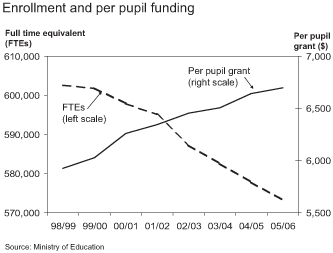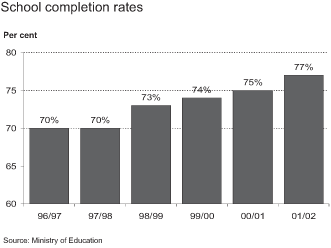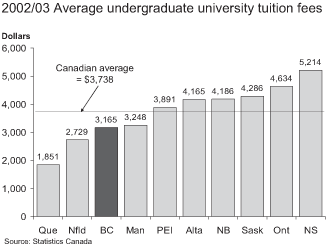Education — Key to our Future
K-12 Education Sector
K-12 Education Budgets
Recognizing the importance of education to both the economy
and society, the provincial government has protected and
increased the Education budget and will now begin to increase
funding as the economy grows.
- School districts were provided additional one-time funding
of $43 million in 2001/02 to improve student achievement
and a further $50 million of one time funding will be
provided in 2002/03.
- The budget in 2003/04 will be maintained at $4.86 billion.
- In 2004/05 there will be a budget increase of $83 million
and a further budget increase of $60 million in 2005/06.
Enrollment and Per Pupil Funding
The enrollment in schools has been declining since 1998/99.
In the 2003/04 school year, public school enrollment is
projected to decline approximately 4,700 students (0.8 per cent)
from 2002/03.

Enrolment has declined by 18,023 student FTEs (3.0 per
cent) since 1998/99 and a further decline of 13,981 student
FTEs (2.4 per cent) is anticipated over the 2003/04 - 2005/06
period.
At the same time, the per pupil funding has increased.
The per pupil amount for the 2003/04school year will increase
$51 from 2002/03 and is projected to increase $139 in 2004/05
and $53 in 2005/06.
K-12 Performance
The two key goals of the Ministry of Education are improved
student achievement and a high quality, performance-oriented
education system in British Columbia.
The school completion rate is the percentage of Grade 8
students who graduate with a Dogwood Diploma within six
years. Over the past six years, the percentage has increased
from 70 per cent in 1996/97 to 77 per cent in 2001/02. The
ministry's plan is to meet or exceed the 77 per cent completion
rate over the next three years.

Further information on performance measures, ministry goals
and challenges can be found in the ministry service plan
and on the government website.
Post Secondary Education (PSE) Sector
PSE Budgets
The government is continuing to protect funding for PSE
and will begin to increase grants as the economy grows:
- 2002/03 spending includes additional one-time contributions
of $23 million to institutes for funding of Leading Edge
Chairs at B.C. universities and Regional Innovation Chairs
at the province's colleges, along with needs in other
priority areas.
- 2003/04 and 2004/05 funding will be maintained at $1.90
billion
- 2005/06 funding will be increased by $30 million to
$1.93 billion.
PSE Enrollment
Currently, there are 157,700 student spaces in public post-secondary
institutions. The private academic degree-granting sector
has approximately 8,000 spaces.
The government is increasing access to PSE to create more
opportunities for students to fill the need for skilled
professionals in the province. Some highlights include:
- adding 2,700 new student spaces in 2002/03,including
825 new spaces for computer science and electrical and
computer engineering and 700 new spaces for nurses and
health care workers;
- completion of a $45-million Leading Edge Endowment Fund,
cost-shared with the private sector, to establish 20 BC
Leadership Chairs in the fields of medical, social, environmental
and technological research — the first Leadership
Chair in spinal cord research has already been established;
- commit $7.5 million to establish 6 Regional Innovation
Chairs at provincial colleges;
Supporting research and development through the Michael
Smith Foundation for Health Research, investments in the
BC Knowledge Development Fund, a life sciences strategy
and a $110 million Life Sciences Centre.
Tuition
Lifting the tuition freeze and allowing institutions to
set their own tuition provides greater flexibility in expanding
programs and services for students. The following chart
shows that B.C. is third lowest among the provinces and
below the Canadian average for university undergraduate
tuition fees.

Further information on performance measures, ministry goals
and challenges can be found in the ministry service plan
and on the government website.
|
